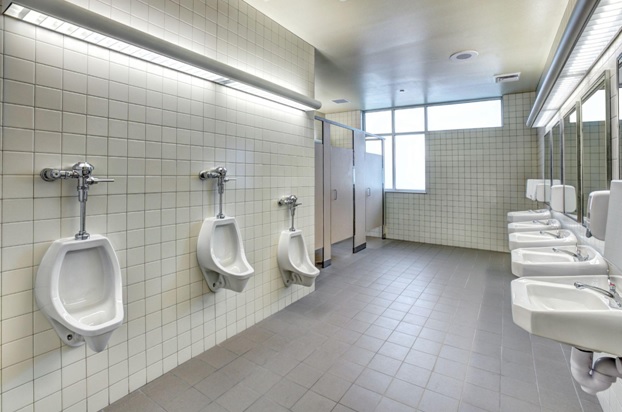Piston vs. Diaphragm Urinal Flushometers: A Closer Look
Mar 27th 2024
In the professional plumbing community, there has long been debate regarding which sort of urinal flushometer technology is superior, namely with respect to piston vs. diaphragm operation.
However, to take a fair approach to assess the benefits of each, it’s not as simple as declaring one design superior to the other.
Instead, we need to consider how they work, what their relative advantages are, and what sorts of factors influence this takeaway.
Piston Urinal Flushometer Operation; Advantages of Design
Piston urinal flushometers consist of an upper and lower chamber connected via a bypass. A molded cup with a rubber lip seal, connected to a piston, seals the upper and lower chambers.
The side of the piston contains the bypass, and the two chambers are separated by a relief valve.
When the urinal flushometer handle is depressed a plunger is pushed against the relief valve, which tilts it and allows water from the upper chamber to flow through; lowering the water pressure above the relief valve.
When the pressure in the upper chamber drops past a certain threshold, higher line water pressure under the piston lifts the cup, allowing water to flow in. With the piston lifted, the relief valve is reseated and water flows through the bypass until pressure is equalized, forcing the piston back down and shutting off the water supply.
In areas with water that contain a high concentration of particulates, chlorine and chloramines may be conducive to piston models if only because chlorine can degrade the elastomeric components of diaphragm flushometers and particulate debris can wedge itself under the diaphragm, compromising the seal. (Although, this can also occur to the seal of a piston flushometer.)
Line water pressure will also impact how suitable a flushometer design is to the given circumstances, generally speaking, lower water pressure environments favor piston flushometers - although more factors would need to be considered before making a choice one way or the other.
Diaphragm Urinal Flushometer Operation; Advantages of Design
By contrast, instead of a piston, diaphragm urinal flushometers feature a flexible rubber diaphragm with a bypass hole that sits between the upper and lower chambers. At rest, pressure from the upper chamber presses the diaphragm over the orifice between the two chambers and seals them off.
When the handle is depressed, the handle plunger shifts the relief valve, tilting it in a fashion similar to that experienced by piston urinal flushometers.
However, in a diaphragm model, the tilted relief valve creates a slightly higher pressure in the lower chamber, which pushes up on the diaphragm, lifting it and allowing water to flow between the two chambers.
As water flows in, pressure begins to equalize once more, reseating the relief valve, and flowing through the bypass in the diaphragm until it reaches such pressure that the diaphragm is once more seated and sealed between the two chambers.
Diaphragm urinal flushometers tend to perform better in restrooms that experience high traffic as less time is needed for a diaphragm model to recover between flushes; they can be flushed in vary rapid succession with minimal recovery time.
Whereas it was stated above that lower pressure environments tend to favor piston flushometers, the opposite is true for diaphragm flushometers, which tend to perform more favorably in the presence of high water line pressure, which generally allows flexible diaphragms to create more reliable, stronger seals within the flushometer body.

It’s Not as Simple as “One over the Other”
While a few advantages each of piston and diaphragm urinal flushometers were mentioned in the preceding sections, it is important to note that to truly select a flushometer that is best fit for a commercial plumbing scenario, many more factors will need to be evaluated, including but not limited to:
- Restroom traffic: How many cycles the flushometer is put through per day, and in what sort of succession, is one of the chief determinants of how suitable a flushometer is in a given situation.
- Operating conditions: Weak systems with lower GPF ratings and systems that encounter lower water line pressures tend to favor piston flushometers, but each situation should be evaluated on a case by case basis.
- Water quality: Water quality, including the presence of chlorine, chloramines and particulate matter should also be considered, in addition to water conductivity, pH, and even biomass in the water.
Ultimately, and despite the fact that diaphragm urinal flushometers have a pronounced range of advantages over piston models, there is no hard or fast answer to the question of which one is better. It is a matter of degrees and relativity, as each both have strengths and weaknesses.
Urinal Flushometer Parts from the Industry’s Top Manufacturers
We carry a wide range of urinal flushometers, both manually activated and touchless, sensor-based electronic models, from the industry’s top manufacturers, including but not limited to Sloan, Moen, Kohler, and American Standard.
Whether you have questions about any of their features or just need a new supplier that can get your great prices on manufacturer authentic equipment, contact us at 1-855-251-4591 and we will be happy to help.

